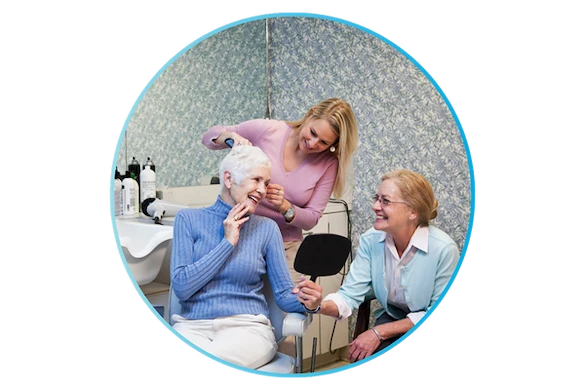
A Comprehensive Guide to Senior Living and Care
Whether you're just starting your search or have found the perfect solution for your senior living and care needs, this guide can help at every step of the way.

Navigating the world of senior living can feel like a maze – so many choices, so many terms you might not understand, and the pressure to find the perfect fit. Senior Care Finder is here to help you every step of the way. We've created this comprehensive guide to empower you with the knowledge and resources you need to make this journey a little easier. Here, you'll find clear explanations of:
- different types of care
- explore the amenities offered in senior communities
- understand the various room options available
- learn key terms you might encounter
- understand financial considerations
- access to additional resources
So, take a deep breath and let Senior Care Finder help you make this decision with confidence.
Key Takeaways



Types of Care
Navigating the world of senior living can feel overwhelming. With so many options available, understanding the different types of care and how to find the right provider is crucial. This section will provide a clear overview of each senior living and care option, helping you make informed decisions for yourself or a loved one.
| Active Adult | Active adult communities are a type of senior living, designed for independent and active seniors, usually aged 55 and older. These communities offer amenities like maintenance services, fitness centers, and social activities, but do not provide extensive healthcare or assistance with daily tasks like assisted living does. These communities allow seniors to enjoy a vibrant, active lifestyle and engage with others their age. Search for active adult communities near you. |
| Adult Day | Adult day care is designed to relieve a caregiver of daytime duties while ensuring their loved ones recieve proper care in a safe and caring environment. These services offer care and companionship for older adults who need assistance or supervision, and for those who seek daily interaction. Adult day care centers are typically open on weekdays when a family member or caregiver is working. There are three main types of adult day care centers: those focused mainly on social interaction, those that provide medical care, and those dedicated to Alzheimer’s and memory support. Find adult day services. |
| Assisted Living | Assisted living is a type of residential facility designed for people who need various levels of personal and medical care. It offers living spaces such as apartments or rooms and promotes independence in a home-like atmosphere. Assisted living communities provide services like assistance with daily tasks, meal preparation, housekeeping, transportation, security features, social activities, and limited medical care, all contributing to a maintenance-free lifestyle in a safe and secure environment that promotes independence and well-being. Find assisted living communities near you. |
| Board and Care Homes | Also known as residential care homes. |
| Companionship | Companionship refers to the social and emotional support provided by caregivers or home health aides. It involves spending time with seniors, engaging in conversation, participating in stimulating activities together, and offering emotional support. Companionship helps seniors combat the feelings of loneliness and isolation, promotes mental well-being, and enhances their overall quality of life. |
| Continuing Care Retirement Community (CCRC) | A continuing care retirement community (CCRC) offers a continuum of care services to residents as their needs change over time. In a CCRC, seniors typically move in while they are still independent and able to care for themselves. As they age and require more assistance, they can transition to higher levels of care within the same community, like assisted living, memory care, or skilled nursing care. CCRCs provide a comprehensive and seamless approach to senior care, allowing residents to age in place and receive the appropriate level of support without having to relocate to a different community. |
| Home Care (Medicare-Certified) |
Medicare-certified home care provides a variety of health and personal care services in the comfort of your own home. These providers are typically used after a hospital stay in leu of moving into a skilled nursing/long-term care community. Services are provided by a skilled nurse or qualified home health aide and may include medication administration, respiratory monitoring, post-surgical care, or post-stroke care. For a person to qualify for services from a Medicare-certified home health care, they must meet certain criteria. Search for home care (Medicare-certified) near you. |
| Home Care (Non-Medical) |
Non-medical home care, also sometimes referred to as companion care or private duty care, provides assistance with daily living activities in the comfort of your own home. It differs from Medicare certified home health and communities like assisted living and long-term care in that it does not provide medical support. Non-medical home care provides support with daily tasks such as cooking, housekeeping, help with bathing, dressing or toileting, and companionship. Care plans are tailored to meet the specific needs and preferences of each individual. Find home care (non-medical) today. |
| Hospice | Hospice care is a specialized approach to end-of-life care that focuses on providing comfort, support, and dignity to individuals facing a terminal illness. It aims to enhance the quality of life for patients and their families during the challenging time of dying. Hospice care is typically provided by a team of healthcare professionals, including doctors, nurses, social workers, counselors, and volunteers, who work collaboratively to ensure holistic support. Hospice care can be delivered at home, in a nursing home, or in a specialized hospice facility. Search for hospice care near you. |
| Independent Living | Independent living are residential communities designed for adults aged 55 and older who are do not require significant medical care or assistance. These communities offer a maintenance-free lifestyle and private living spaces, along with amenities and services tailored to the needs and preferences of active seniors. Residents in independent living typically have access to recreational centers, fitness areas, dining services, and transportation. Independent living allows seniors to maintain their autonomy and enjoy a fulfilling lifestyle while benefiting from the convenience and social opportunities provided by the community. Find independent living communities. |
| Long-Term Care/ Skilled Nursing |
Long-term care/skilled nursing, often referred to as a "nursing home," provides a higher level of medical support than what's typically available at home. Skilled nursing facilities (SNFs) are licensed to provide around-the-clock medical care, encompassing both long-term care and short-term rehabilitation. This makes them the highest level of care available outside of a hospital setting. Long-term care/skilled nursing communities offer a combination of medical care, personal assistance, and supportive services for individuals who need ongoing help with daily living activities. Find nursing homes near you. |
| Low-Income/ Affordable Housing |
Low-income or affordable senior housing are properties designed for older adults with limited financial resources. In order to offer reasonably priced rent, these communities are often subsidized by government or non-profit organizations, ensuring affordability for residents. To qualify, seniors must meet certain income requirements. |
| Memory Care | Memory care communities are designed to create a safe, secure, and stimulating environment for seniors with memory challenges. These communities offer a structured daily routine, specialized activities, and compassionate care that fosters emotional well-being and supports cognitive function. Memory care communities are staffed with highly-trained professionals who strive to create a familiar and comfortable setting where residents can feel secure and engaged. Search for memory care communities today. |
| Residential Care Home | Residential care homes (also known as board and care homes) provide a supportive living environment for individuals who require assistance with daily activities but don’t need skilled nursing care - similar to assisted living, but in a personal home setting rather than a large community. These homes offer a middle ground between independent living and skilled nursing facilities. |
| Respite Care | Respite care refers to short-term care provided to seniors to give their primary caregivers a break from their caregiving responsibilities. Respite care services typically include assistance with activities of daily living (ADLs), supervision, companionship, and may also involve medical or therapeutic support, depending on the individual's needs. Respite care offers temporary relief for caregivers while ensuring that seniors receive the care and support they need during their absence. |

Types of Care
Navigating the world of senior living can feel overwhelming. With so many options available, understanding the different types of care and how to find the right provider is crucial. This section will provide a clear overview of each senior living and care option, helping you make informed decisions for yourself or a loved one.
Active Adult: communities are a type of senior living, designed for independent and active seniors, usually aged 55 and older. These communities offer amenities like maintenance services, fitness centers, and social activities, but do not provide extensive healthcare or assistance with daily tasks like assisted living does. These communities allow seniors to enjoy a vibrant, active lifestyle and engage with others their age. Search for active adult communities near you.
Adult daycare: is designed to relieve a caregiver of daytime duties while ensuring their loved ones receive proper care in a safe and caring environment. These services offer care and companionship for older adults who need assistance or supervision, and for those who seek daily interaction. Adult day care centers are typically open on weekdays when a family member or caregiver is working. There are three main types of adult day care centers: those focused mainly on social interaction, those that provide medical care, and those dedicated to Alzheimer’s and memory support. Find adult day services.
Assisted living: is a type of residential facility designed for people who need various levels of personal and medical care. It offers living spaces such as apartments or rooms and promotes independence in a home-like atmosphere. Assisted living communities provide services like assistance with daily tasks, meal preparation, housekeeping, transportation, security features, social activities, and limited medical care, all contributing to a maintenance-free lifestyle in a safe and secure environment that promotes independence and well-being. Find assisted living communities near you.
Board and care homes: also known as residential care homes.
Companionship: refers to the social and emotional support provided by caregivers or home health aides. It involves spending time with seniors, engaging in conversation, participating in stimulating activities together, and offering emotional support. Companionship helps seniors combat the feelings of loneliness and isolation, promotes mental well-being, and enhances their overall quality of life.
Continuing care retirement communities (CCRC's): offers a continuum of care services to residents as their needs change over time. In a CCRC, seniors typically move in while they are still independent and able to care for themselves. As they age and require more assistance, they can transition to higher levels of care within the same community, like assisted living, memory care, or skilled nursing care. CCRCs provide a comprehensive and seamless approach to senior care, allowing residents to age in place and receive the appropriate level of support without having to relocate to a different community.
Medicare-certified home care: provides a variety of health and personal care services in the comfort of your own home. These providers are typically used after a hospital stay in leu of moving into a skilled nursing/long-term care community. Services are provided by a skilled nurse or qualified home health aide and may include medication administration, respiratory monitoring, post-surgical care, or post-stroke care. For a person to qualify for services from a Medicare-certified home health care, they must meet certain criteria. Search for home care (Medicare-certified) near you.
Non-medical home care: also sometimes referred to as companion care or private duty care, provides assistance with daily living activities in the comfort of your own home. It differs from Medicare certified home health and communities like assisted living and long-term care in that it does not provide medical support. Non-medical home care provides support with daily tasks such as cooking, housekeeping, help with bathing, dressing or toileting, and companionship. Care plans are tailored to meet the specific needs and preferences of each individual. Find home care (non-medical) today.
Hospice care: is a specialized approach to end-of-life care that focuses on providing comfort, support, and dignity to individuals facing a terminal illness. It aims to enhance the quality of life for patients and their families during the challenging time of dying. Hospice care is typically provided by a team of healthcare professionals, including doctors, nurses, social workers, counselors, and volunteers, who work collaboratively to ensure holistic support. Hospice care can be delivered at home, in a nursing home, or in a specialized hospice facility. Search for hospice care near you.
Independent living: are residential communities designed for adults aged 55 and older who are do not require significant medical care or assistance. These communities offer a maintenance-free lifestyle and private living spaces, along with amenities and services tailored to the needs and preferences of active seniors. Residents in independent living typically have access to recreational centers, fitness areas, dining services, and transportation. Independent living allows seniors to maintain their autonomy and enjoy a fulfilling lifestyle while benefiting from the convenience and social opportunities provided by the community. Find independent living communities.
Long-term care/skilled nursing: often referred to as a "nursing home," provides a higher level of medical support than what's typically available at home. Skilled nursing facilities (SNFs) are licensed to provide around-the-clock medical care, encompassing both long-term care and short-term rehabilitation. This makes them the highest level of care available outside of a hospital setting. Long-term care/skilled nursing communities offer a combination of medical care, personal assistance, and supportive services for individuals who need ongoing help with daily living activities. Find nursing homes near you.
Low-income or affordable senior housing: are properties designed for older adults with limited financial resources. In order to offer reasonably priced rent, these communities are often subsidized by government or non-profit organizations, ensuring affordability for residents. To qualify, seniors must meet certain income requirements.
Memory care: communities are designed to create a safe, secure, and stimulating environment for seniors with memory challenges. These communities offer a structured daily routine, specialized activities, and compassionate care that fosters emotional well-being and supports cognitive function. Memory care communities are staffed with highly-trained professionals who strive to create a familiar and comfortable setting where residents can feel secure and engaged. Search for memory care communities today.
Residential care homes: (also known as board and care homes) provide a supportive living environment for individuals who require assistance with daily activities but don’t need skilled nursing care - similar to assisted living, but in a personal home setting rather than a large community. These homes offer a middle ground between independent living and skilled nursing facilities.
Respite care: refers to short-term care provided to seniors to give their primary caregivers a break from their caregiving responsibilities. Respite care services typically include assistance with activities of daily living (ADLs), supervision, companionship, and may also involve medical or therapeutic support, depending on the individual's needs. Respite care offers temporary relief for caregivers while ensuring that seniors receive the care and support they need during their absence.
Amenities
Senior living communities offer a variety of amenities that enhance the resident experience and cater to diverse needs. Evaluating these amenities can be a powerful tool when comparing communities and finding the perfect fit. This section will explore some of the most common senior living amenities, explaining what they are and helping you identify which ones are most important to you or your loved one.
| Beauty Salon | A beauty salon is operated by hairstylists and aestheticians who provide grooming services such as haircuts, nail care, and other beauty treatments to residents. |
| Community Sponsored Activities |
Community-sponsored activities are events or programs organized by the community, often with the help of an activity director. These activities can include various daily or scheduled events to engage and entertain residents. |
| Guest Housing | Guest housing refers to private rooms or bedrooms designated for visitors to stay overnight. |
| Maintenance | Maintenance service involves having a maintenance worker on staff who is available for personal room repairs, lawn care, or snow removal. |
| Meal Preparation & Services | Meal preparation and services includes the community providing food and preparing meals for residents to enjoy dining on-site. |
| Media & Activities Room | A media and activities room is a designated space equipped for various activities, including watching movies and television. |
| Medication Management | Medication management involves overseeing and assisting residents with their medications, ensuring they take the correct doses at the right times as prescribed by their healthcare providers. |
| Off-Site Trips | Off-site trips are organized outings for residents, including visits to restaurants, movies, the zoo, and other activities away from the community premises. |
| Restaurant Style Dining | Restaurant-style dining, typically found in resort-style settings, offers residents a dining experience similar to that of restaurants. It includes servers, table service, and larger dining rooms to accommodate guests. |
| Scheduled Transportation (Non-Medical) |
Scheduled transportation (non-medical) refers to group transportation services provided for residents to places such as the grocery store, pharmacy, Target, and other non-medical destinations, according to a set schedule. |
| Transportation to Doctors' Appointments |
Transportation to doctors' appointments involves offering either paid or complimentary transportaion services for residents to attend their medical appointements. |

Amenities
Senior living communities offer a variety of amenities that enhance the resident experience and cater to diverse needs. Evaluating these amenities can be a powerful tool when comparing communities and finding the perfect fit. This section will explore some of the most common senior living amenities, explaining what they are and helping you identify which ones are most important to you or your loved one.
Beauty salons: are operated by hairstylists and aestheticians who provide grooming services such as haircuts, nail care, and other beauty treatments to residents.
Community-sponsored activities: are events or programs organized by the community, often with the help of an activity director. These activities can include various daily or scheduled events to engage and entertain residents.
Guest housing: refers to private rooms or bedrooms designated for visitors to stay overnight.
Maintenance: a service that involves having a maintenance worker on staff who is available for personal room repairs, lawn care, or snow removal.
Meal preparation and services: includes the community providing food and preparing meals for residents to enjoy dining on-site.
Media and activities room: a designated space equipped for various activities, including watching movies and television.
Medication management: involves overseeing and assisting residents with their medications, ensuring they take the correct doses at the right times as prescribed by their healthcare providers.
Off-site trips: are organized outings for residents, including visits to restaurants, movies, the zoo, and other activities away from the community premises.
Restaurant-style dining, typically found in resort-style settings, offers residents a dining experience similar to that of restaurants. It includes servers, table service, and larger dining rooms to accommodate guests.
Scheduled transportation (non-medical): refers to group transportation services provided for residents to places such as the grocery store, pharmacy, Target, and other non-medical destinations, according to a set schedule.
Transportation to medical appointments: involves offering either paid or complimentary transportaion services for residents to attend their medical appointements.
Room Types
After choosing the type of care and desired amenities, it's time to explore the available living spaces. Senior communities offer a variety of room types, each with its own unique features and benefits. Understanding these options will help you select the living space that best suits your needs and preferences. This section will provide a breakdown of common room types found in senior living or care communities.
| Private Suites | A private suite is a room with a single bed, offering personal space for one person. |
| Shared Suite | A shared suite is a room with multiple beds in one space. It often has a curtain partition to offer a degree of privacy; it is sometimes referred to as a "semi-private" room. |
| Studio | A studio room is a compact living space that combines a bedroom, living room area, and kitchen into one room, maximizing efficiency and convenience. |
| One Bedroom | A one-bedroom is a living space where the bed is in its own room, separate from the living room and kitchen, providing distinct spaces for sleeping and relaxing/cooking. |
| Two Bedroom |
A two-bedroom is a living space with two separate bedrooms, a living room, and a kitchen, providing distinct spaces for sleeping and relaxing/cooking. |
| Three Bedroom | A three-bedroom is a living space with three separate bedrooms, a living room, and a kitchen, providing distinct spaces for sleeping and relaxing/cooking. |

Room Types
After choosing the type of care and desired amenities, it's time to explore the available living spaces. Senior communities offer a variety of room types, each with its own unique features and benefits. Understanding these options will help you select the living space that best suits your needs and preferences. This section will provide a breakdown of common room types found in senior living or care communities.
Private suite: a room with a single bed, offering personal space for one person.
Shared suite: a room with multiple beds in one space. It often has a curtain partition to offer a degree of privacy; it is sometimes referred to as a "semi-private" room.
Studio: a room that is a compact living space, combining a bedroom, living room area, and kitchen into one room- maximizing efficiency and convenience.
One-bedroom: a living space where the bed is in its own room, separate from the living room and kitchen, providing distinct spaces for sleeping and relaxing/cooking.
Two-bedroom: a living space with two separate bedrooms, a living room, and a kitchen, providing distinct spaces for sleeping and relaxing/cooking.
Three-bedroom: a living space with three separate bedrooms, a living room, and a kitchen, providing distinct spaces for sleeping and relaxing/cooking.
Key Terms
When researching senior living and care options, you might encounter unfamiliar terms. Understanding these terms is essential for making informed decisions. This section will provide a glossary of key terms related to senior living and care, helping you navigate the search process with confidence.
| Activities of Daily Living (ADLs) |
Activities of daily living (ADLs) are fundamental skills that individuals typically perform every day to take care of themselves and maintain their independence. These activities are essential for basic functioning and include bathing, eating, toileting, mobility, personal hygiene, and dressing. |
| Aging in Place | Aging in place is the ability to independently and comfortably live in one's home or community for as long as possible as they age. This concept emphasizes the desire of seniors to remain in familiar settings rather than relocating to assisted living communities or nursing homes. Aging in place often involves making modifications to the home environment, accessing supportive services like home care, and promoting social connections to help seniors maintain their quality of life and independence as they grow older. |
| Alzheimer's Disease | Alzheimer's disease is a progressive neurological disorder that affects the brain, leading to memory loss and cognitive decline. It is the most common form of dementia. Symptoms of Alzheimer's disease typically worsen over time, starting with mild memory loss and progressing to severe impairment in memory, reasoning, judgment, and language. There is currently no cure for Alzheimer's disease, but treatments can help manage symptoms and improve quality of life for affected individuals. |
| Centers for Medicare & Medicaid Services (CMS) |
The Centers for Medicare & Medicaid Services (CMS) is a federal agency within the U.S. Department of Health and Human Services (HHS). It oversees two major healthcare programs in the United States: Medicare and Medicaid. CMS operates with the mission to improve the health and well-being of Americans by providing access to high-quality, affordable healthcare coverage and services through Medicare, Medicaid, and other programs. CMS offers ratings for three service types found on Senior Care Finder, hospice, home care (medicare-certified), and long-term care/skilled nursing. |
| Conservatorship | A conservatorship, also known as guardianship, is a legal arrangement where a court appoints a person or organization to manage the financial affairs and/or personal care of an individual who is unable to make decisions for themselves, typically due to advanced age, illness, or disability. The appointed conservator, also known as a guardian, is responsible for making decisions on behalf of the incapacitated individual to ensure their needs are met and their best interests are protected. |
| Continuum of Care | Continuum of care is a holistic approach to senior living that provides an integrated system of care that allows residents to transition seamlessly between various levels of care as their needs evolve over time. This flexibility ensures residents can access the appropriate level of care without the disruption of relocating to a different community, promoting continuity and stability in their living. |
| Dementia | Dementia is a general term used to describe a decline in cognitive function severe enough to interfere with daily life. It is not a specific disease but rather a group of symptoms characterized by memory loss, impaired reasoning, communication difficulties, and changes in behavior. Dementia is often progressive, meaning symptoms may start out slowly and then gradually get worse over time. |
| Power of Attorney |
A power of attorney is a legal document that allows an individual (the principal), to designate a person (the agent or attorney-in-fact) to act on their behalf in legal, financial, and/or medical matters. A power of attorney is useful for seniors who may need assistance managing their affairs, especially if they become incapacitated and are unable to do so themselves. |

Key Terms
When researching senior living and care options, you might encounter unfamiliar terms. Understanding these terms is essential for making informed decisions. This section will provide a glossary of key terms related to senior living and care, helping you navigate the search process with confidence.
Activities of daily living (ADLs): are fundamental skills that individuals typically perform every day to take care of themselves and maintain their independence. These activities are essential for basic functioning and include bathing, eating, toileting, mobility, personal hygiene, and dressing.
Aging in place: is the ability to independently and comfortably live in one's home or community for as long as possible as they age. This concept emphasizes the desire of seniors to remain in familiar settings rather than relocating to assisted living communities or nursing homes. Aging in place often involves making modifications to the home environment, accessing supportive services like home care, and promoting social connections to help seniors maintain their quality of life and independence as they grow older.
Alzheimer's disease: is a progressive neurological disorder that affects the brain, leading to memory loss and cognitive decline. It is the most common form of dementia. Symptoms of Alzheimer's disease typically worsen over time, starting with mild memory loss and progressing to severe impairment in memory, reasoning, judgment, and language. There is currently no cure for Alzheimer's disease, but treatments can help manage symptoms and improve quality of life for affected individuals.
The Centers for Medicare & Medicaid Services (CMS): is a federal agency within the U.S. Department of Health and Human Services (HHS). It oversees two major healthcare programs in the United States: Medicare and Medicaid. CMS operates with the mission to improve the health and well-being of Americans by providing access to high-quality, affordable healthcare coverage and services through Medicare, Medicaid, and other programs. CMS offers ratings for three service types found on Senior Care Finder, hospice, home care (medicare-certified), and long-term care/skilled nursing.
Conservatorship: also known as guardianship, is a legal arrangement where a court appoints a person or organization to manage the financial affairs and/or personal care of an individual who is unable to make decisions for themselves, typically due to advanced age, illness, or disability. The appointed conservator, also known as a guardian, is responsible for making decisions on behalf of the incapacitated individual to ensure their needs are met and their best interests are protected.
Continuum of care: is a holistic approach to senior living that provides an integrated system of care that allows residents to transition seamlessly between various levels of care as their needs evolve over time. This flexibility ensures residents can access the appropriate level of care without the disruption of relocating to a different community, promoting continuity and stability in their living.
Dementia: is a general term used to describe a decline in cognitive function severe enough to interfere with daily life. It is not a specific disease but rather a group of symptoms characterized by memory loss, impaired reasoning, communication difficulties, and changes in behavior. Dementia is often progressive, meaning symptoms may start out slowly and then gradually get worse over time.
Power of attorney: is a legal document that allows an individual (the principal), to designate a person (the agent or attorney-in-fact) to act on their behalf in legal, financial, and/or medical matters. A power of attorney is useful for seniors who may need assistance managing their affairs, especially if they become incapacitated and are unable to do so themselves.
Financial Considerations
The cost of senior living and care is a major consideration. This section will delve into the financial aspects, providing a clear understanding of Medicare and Medicaid coverage, entrance fees, monthly fees, and potential hidden costs. By equipping yourself with this knowledge, you can make sound financial decisions about your senior living options.
| Entrance Fee | An entrance fee is a one-time initial payment that residents make upon their move into a senior living community- primarily at continuing care retirement communities. It is similar to a membership fee that grants them access to the community's amenities, services, and accommodations for the entire duration of their stay- regardless of changing needs. According to AARP, the average entrance fee is $402,000. |
| Medicaid | Medicaid is a joint federal and state program that provides healthcare coverage to eligible individuals aged 65 and older, as well as low income individuals or those living with disabilities. It covers a wide range of medical services including doctor visits, hospital stays, long-term care, prescription drugs, and other services that are not always included with Medicare. Medicaid eligibility varies by state and is typically based on income and assets. |
| Medicare | Medicare is a federal health insurance program, designed primarily for people aged 65 and older. It provides coverage for various medical services, including hospital stays, doctor visits, preventive care, and prescription drugs. Eligible seniors typically receive Medicare benefits automatically upon reaching the age of 65; however, younger individuals with certain disabilities or medical conditions may also qualify. |
| Pricing Structures | Many senior living communities use different pricing models to provide residents with various options and levels of service; there are three main pricing models:
|
| Medicaid Waiver | A Medicaid waiver allows states to waive certain Medicaid requirements to expand their coverage and support to individuals who would otherwise need to reside in long term care facility or nursing home. As a result, individuals are oftentimes able to stay in their homes and receive care. |
| Cost Factors |
There are many cost factors that go into the overall cost of your senior living or care community. Below is a list of the most common pieces that go into the cost of a monthly unit. Learn more about cost factors here.
|
| Hidden Costs of Senior Living |
Depending on a community's pricing model, there may be some unexpected hidden costs, outside of the regular base fee. These hidden costs may include, entrance fees, medication fees, parking fees, pet fees, care services, PT/OT services, beauty salon services, internet, transportation, and more. Understanding these potential hidden costs can help seniors and their families make informed decisions and avoid financial surprises down the road. |

Financial Considerations
The cost of senior living and care is a major consideration. This section will delve into the financial aspects, providing a clear understanding of Medicare and Medicaid coverage, entrance fees, monthly fees, and potential hidden costs. By equipping yourself with this knowledge, you can make sound financial decisions about your senior living options.
Entrance fee: is a one-time initial payment that residents make upon their move into a senior living community- primarily at continuing care retirement communities. It is similar to a membership fee that grants them access to the community's amenities, services, and accommodations for the entire duration of their stay- regardless of changing needs. According to AARP, the average entrance fee is $402,000.
Medicaid: is a joint federal and state program that provides healthcare coverage to eligible individuals aged 65 and older, as well as low income individuals or those living with disabilities. It covers a wide range of medical services including doctor visits, hospital stays, long-term care, prescription drugs, and other services that are not always included with Medicare. Medicaid eligibility varies by state and is typically based on income and assets.
Medicare: is a federal health insurance program, designed primarily for people aged 65 and older. It provides coverage for various medical services, including hospital stays, doctor visits, preventive care, and prescription drugs. Eligible seniors typically receive Medicare benefits automatically upon reaching the age of 65; however, younger individuals with certain disabilities or medical conditions may also qualify.
Pricing structures: many senior living communities use different pricing models to provide residents with various options and levels of service; there are three main pricing models:
- À la Carte Pricing gives seniors the flexibility to choose and pay only services and amenities they want or need, allowing residents to customize their experience. Residents are charged separately for each service they receive, meaning costs can vary widely based on individual preferences and usage.
- All-Inclusive Pricing allows seniors to pay a one fixed fee covering everything from rent, care services, meals, utilities, and other more. This pricing model simplifies budgeting for residents and their families, as there are no surprise costs for additional services. However, it may be more expensive upfront compared to à la carte pricing.
- Tiered Pricing offers different levels of care at varying price points. This allows seniors to select the tier that best aligns with their needs and budget, providing residents greater flexibility and affordability.
Medicaid waiver: this allow states to waive certain Medicaid requirements to expand their coverage and support to individuals who would otherwise need to reside in long term care facility or nursing home. As a result, individuals are oftentimes able to stay in their homes and receive care.
Cost factors: there are many cost factors that go into the overall cost of your senior living or care community. Below is a list of the most common pieces that go into the cost of a monthly unit. Learn more about cost factors here.
- Location: Depending on your location, costs can vary widely - use our city pages to help you find cost for care in a city near you!
- Accommodation Costs: Communities offer various living arrangements and floor plans; the size, location, and amenities of the living space accommodations all contribute to varying costs per room type.
- Meal Expenses: Oftentimes communities provide their residents with meals, and the cost is often included in the overall fee. The quality and variety of meals can impact the cost, as can any special dietary requirements.
- Healthcare Services: The level of medical care required by residents can significantly influence expenses. Basic healthcare services like regular check-ups and medication management may be included, but communities may charge additional fees for more specialized medical care.
- Activities & Amenities: Communities offer a wide range of recreational activities and amenities to enhance the quality of life for residents. Often beauty salons, pets, or PT/OT services cost extra and are not included in the base cost- make sure to ask your provider to be sure you are aware of what's included.
Hidden costs: depending on a community's pricing model, there may be some unexpected hidden costs, outside of the regular base fee. These hidden costs may include, entrance fees, medication fees, parking fees, pet fees, care services, PT/OT services, beauty salon services, internet, transportation, and more. Understanding these potential hidden costs can help seniors and their families make informed decisions and avoid financial surprises down the road.
- Are there any tasks you're having trouble with?
- Would you appreciate some help with household chores like laundry and cooking?
- I worry you're lonely at the house alone, would you like to be closer to a community of individuals your age?
- Have you considered any of the senior living or care communities nearby?
- Is there a particular neighborhood you want to live in?
- What amenities or services are important to you in a community?
- How can I best support you?

- Are there any tasks you're having trouble with?
- Would you appreciate some help with household chores like laundry and cooking?
- I worry you're lonely at the house alone, would you like to be closer to a community of individuals your age?
- Have you considered any of the senior living or care communities nearby?
- Is there a particular neighborhood you want to live in?
- What amenities or services are important to you in a community?
- How can I best support you?
How to Decide on a Community
- Service/Care Type: Are you looking for just independent living? Or are you looking for a community where you can age in place? Easily view all the service types offered at the community you've selected.
- Location: Are you hoping to be near your grocery store or church - view where the community is located on a map to determine if this is the neighborhood you'd like to be in!
- Cost: If the community has shared their pricing, quickly view their monthly price for each service type offered.
- Room Type: Looking for a private room? Make sure to check the community offers the room type you're looking for! Be aware that the cost for some rooms may be higher than the base price they have listed.
- Amenities: Some residents may find a beauty salon to be of high importance, where other residents may appreciate an on-site fitness center.
- Ratings: Through our partnership with CMS (Centers for Medicare and Medicaid Services), long-term care/skilled nursing facilities, hospice care, and home health care (Medicare-certified) have star ratings, allowing users to quickly compare communities.
Tips for Touring Communities
- Make a Priority List: Create a list of important features you want to consider during your tour; these may include amenities, living arrangements, safety features, and healthcare services.
- Observe the Atmosphere: Pay attention to the atmosphere of the community. Is it warm and welcoming? Do residents seem happy and engaged?
- Ask Questions: Don't hesitate to ask plenty of questions during the tour. Inquire about everything from meal options to recreational activities to healthcare services.
- Talk to Residents & Staff: Take the opportunity to talk with current residents and staff members. Their insights can provide valuable perspective on what life is really like in their community.
- Explore Common Areas: Take a thorough tour of common areas, dining rooms, activity rooms, fitness centers, and outdoor spaces. These areas can give you a sense of the community's amenities and social opportunities.
- Take Note of Safety & Accessibility Features: Assess safety features such as handrails, emergency call systems, and accessibility options for residents with mobility issues.
- Review Contracts & Policies: Ask for copies of contracts, pricing information, and community policies so you can review them carefully at home.
- Take Notes & Photos: Take notes and photos during the tour to help you remember important details and compare different communities later on.
Moving into a Senior Community
Additional Resources
We strive to be your one-stop resource for all things senior living and care. However, we recognize the value of having additional resources at your fingertips. This section offers a curated list of reputable resources that can provide further assistance during your senior living journey. These resources can be helpful before, during, and after your search for senior living or care.
Conclusion
Navigating senior living doesn’t have to feel overwhelming. Whether you're planning ahead for yourself or helping a loved one transition into a new stage of life, understanding the types of care, available amenities, room options, and financial considerations is key to making the best possible decision. The more informed you are, the more confident and empowered you’ll feel throughout this journey.
From comparing communities to preparing for a move, every step is easier when you know what to expect—and what questions to ask. Take your time, explore your options, and trust that the right fit is out there.
At Senior Care Finder, we’re here to support you with tools, resources, and a user-friendly platform to help you search, compare, and connect with the senior living solutions that best meet your needs.